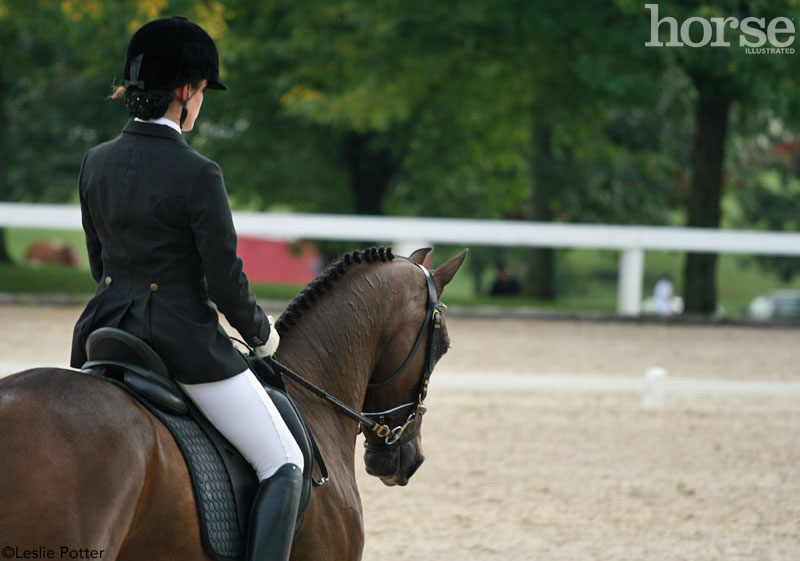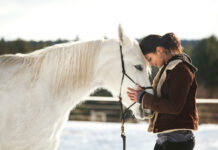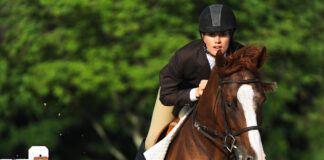
Prepare
There are too many “silly points” lost because of rider errors. Tension from both horse and rider is another cause of problems and mistakes, Brown-Foy says. Attempting more than what you and your horse are capable of is one of the biggest errors. “Make sure you are ready to go to the show,” Brown-Foy says. “Have a few practices at schooling shows before you hit the big time. Also, don’t try to show the same level you are training. Choose the level that is easier for the horse.” Show nerves will have less impact at a level where you and your horse are working confidently and consistently. If you have a judge in your area, even if he or she is not your regular instructor, schedule a lesson to ride practice tests. Ride the ones you are performing at the show, bring along a score sheet and ask the judge to score and make comments. “You can’t change your training right before a show,” Brown-Foy says, “but you can work out a few small details that will result in a higher score.”
Staying on course and riding an accurate test is the most basic way to avoid losing unnecessary points. Know your test. Even if you have a reader, practice together a few times to coordinate the timing of the reader’s instructions so that you’re able to prepare for and execute the movements. Many points are lost due to errors with a reader. Make sure your reader has the right test before you go in the arena. And remember, your reader must start at the beginning of the test and not jump in only where needed.
Study your United States Equestrian Federation (USEF) rule book and know it backward and forward. Losing points for not knowing the rules is embarrassing and a waste of time and effort on the rider’s part—and disqualification even more so.
Practice Important Movements
The walk is a big factor in all the dressage tests and garners many points when correctly executed. The walk is responsible for 50 points in many of the lower level tests. This includes the scores for the medium walk, the free walk (which is doubled) and the gaits score. The submission score can also be a player if there are problems in the walk, such as resistance. Yet riders tend to use it as a time to rest, adjust their clothing and take surreptitious looks at the judge. It’s a big rookie mistake, but common, to waste the walk.
The walk is important because it shows how supple the horse’s back is and is an indicator that training is going in the right direction. Still, your horse has to learn that a free walk on the long rein means relaxation and not a time to sightsee. “With the walk, several times during your schooling sessions you need to drop the reins and keep walking until the horse relaxes—it is the only way it will work in the competition arena,” Brown-Foy says.
You will need to be able to perform each movement in the test with 90 percent success at home if you expect to pull it off at the show. Don’t practice the whole test straight through more than a few times, instead work on sections. Practice each movement with precision, whether it’s accurate circles or flowing transitions.
Be sure to school the tests in a regulation-size dressage arena so that you will know where the letters are and how to make accurate figures. If you don’t have regular access to one, it’s worth the effort to trailer out to a dressage arena for some practice sessions. Even better if you can try to make an arena at home.
The Test: Requirements and Co-efficients
The purpose of the tests are printed on the top of each one. Read them very carefully and understand what the requirements are so that you can demonstrate these to the judge.
Pay attention to certain movements because the judges’ marks are multiplied by the corresponding co-efficient. For example, a movement with a co-efficient of 2 will be scored double. “The co-efficient is what the test writing committee feels is the most difficult part of the test,” Brown-Foy says. “So if you have fours on all your co-efficient movements, then the score for submission and/or rider [in the collective marks] won’t be very high, as you have not performed the most difficult part of the test.”
The Collective Marks
Those scores at the bottom of your test sheet—collective marks—matter a great deal, after all, they are worth double, and even triple, the score. “The collective marks reflect the top of the test,” Brown-Foy says. “The horse’s gait score reflects his movement, or what you have improved or ruined with training. The impulsion score can be affected by tension in the [horse’s] back, or a lazy performance. The submission score reflects the willingness of the horse. Remember, the more impulsion you have the more submission you need. So it’s better to have a quiet and harmonious, but slightly boring, performance rather than to race around.”
The rider score in the collective marks is now tripled as of the 2007 tests, which means the only way to improve this score is with a correct seat and classical aids. This can be accomplished by taking longe lessons or lessons from an instructor who specializes in seat and position. “The judges will give you the lowest score if they feel your aids and seat are harming the horse, or confusing the horse,” Brown-Foy says. “The lowest score won’t be submission if the horse cannot possibly perform due to a faulty rider.”
There are quite a few ways you can improve your dressage scores. The beauty of dressage competition is that you can see how the judge scored each movement of your test, and receive commentary that is useful for your schooling. You’ll know exactly where you lost points, and what you need to work on. Chart your training progress by the numbers and you’ll see increased scores—and personal satisfaction—down the road.
Tips At-A-Glance >>
Look Good, Ride Better >>
Sharon Biggs is a dressage instructor and frequent contributor to Horse Illustrated. She is the author of In One Arena (Half-Halt Press) and the soon-to-be-released Advanced English Horsemanship (BowTie Press).






great advice
This was very helpful.
This is a truthful and to-the-point article. It’s true that rookies tend to ‘relax’ at the walk, so it generally makes the mistakes happen then. Thanks again, HC!